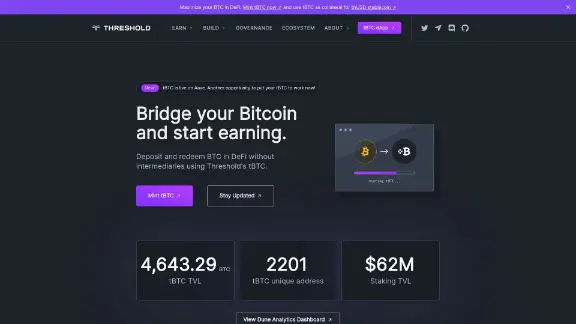tBTC (TBTC)
tBTC (TBTC) is an ERC-20 token that represents Bitcoin (BTC) on the Ethereum blockchain. Each tBTC token is backed by one Bitcoin, maintaining a 1:1 collateralization ratio. This protocol creates a decentralized bridge between Bitcoin and Ethereum, allowing Bitcoin holders to engage with Ethereum's decentralized finance (DeFi) ecosystem without relying on centralized intermediaries. tBTC is part of the Threshold Network, which utilizes cryptographic and privacy-preserving technologies.
Overview of tBTC
tBTC enables interoperability between Bitcoin and Ethereum by allowing users to mint an Ethereum-compatible token, tBTC, backed by Bitcoin. This token can be utilized in a variety of DeFi applications, including lending protocols, decentralized exchanges, and liquidity pools. The protocol employs threshold cryptography and distributed key generation (DKG) to securely manage Bitcoin deposits and redemptions. A decentralized network of signers, who stake Ethereum (ETH) as collateral, ensures the security of the Bitcoin reserves backing tBTC.
History of tBTC

| Ticker | TBTC |
| Category | Crypto-Backed Tokens |
| Website | https://threshold.network/ |
| @TheTNetwork | |
| Telegram | thresholdnetwork |
| https://www.reddit.com/r/thresholdnetwork | |
| Contract Addresses | |
|---|---|
| ethereum | 0x18...88 Copied! Copied! |
| polygon-pos | 0x23...4b Copied! Copied! |
| bob-network | 0xbb...e2 Copied! Copied! |
| optimistic-ethereum | 0x6c...40 Copied! Copied! |
| arbitrum-one | 0x6c...40 Copied! Copied! |
| base | 0x23...4b Copied! Copied! |
| solana | 6D...cU Copied! Copied! |
tBTC was developed by Thesis, a software firm also responsible for the Keep Network. Founded by Matt Luongo and Corbin Pon, Thesis aimed to create a decentralized bridge to integrate Bitcoin into Ethereum-based applications. The initial version of tBTC launched in 2020. Its subsequent release, tBTC v2, was launched under the Threshold Network, which merged the capabilities of the Keep Network and NuCypher, providing a scalable, decentralized alternative to centralized Bitcoin tokenization solutions.
Technology behind tBTC
tBTC utilizes cryptographic and decentralized mechanisms to ensure trustless operations and secure custody of Bitcoin reserves.
Minting tBTC
- A unique Bitcoin deposit address is generated through the Threshold Network dashboard.
- Users deposit Bitcoin into this address, secured by a randomly selected group of signers.
- Upon confirmation of the Bitcoin deposit, an equivalent amount of tBTC is minted and transferred to the user’s Ethereum wallet.
Redemption process
- Users initiate redemption by sending their tBTC tokens to the protocol’s smart contract.
- The tokens are burned, and the equivalent Bitcoin is released to the user’s specified Bitcoin address.
Signers and security
- Random selection: Signers are chosen through a cryptographic random beacon mechanism.
- Collateralization: Signers bond Ethereum (ETH) as collateral.
- Multi-signature custody: Bitcoin reserves are managed through a decentralized multi-signature wallet system.
Key features
- Decentralization: Managed by a network of independent nodes.
- Trustless operations: Governed by cryptographic protocols and smart contracts.
- Transparency: Reserves and operations are publicly verifiable on both Bitcoin and Ethereum blockchains.
- DeFi integration: Compatible with major decentralized finance platforms.
Use cases
- DeFi collateral: Used as collateral in lending protocols like AAVE and Compound.
- Liquidity provision: Deposited into liquidity pools on platforms such as Uniswap and Curve.
- Yield farming: Staked in various DeFi protocols for passive income.
- Stablecoin minting: Serves as collateral for minting decentralized stablecoins, such as thUSD.
Governance of tBTC
tBTC is governed by the Threshold DAO, a decentralized organization comprising holders of the Threshold Network’s native token, T. The DAO oversees protocol updates, integrations, and operational adjustments, enabling community-driven decision-making while aligning with decentralization principles.
tBTC offers a decentralized solution for bridging Bitcoin to Ethereum, allowing Bitcoin holders to participate in Ethereum’s DeFi ecosystem with a focus on decentralization and security.
